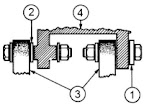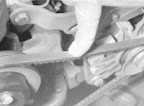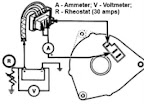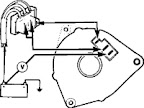Ford Fiesta alternator diagrams - is a part of Ford Fiesta repair manuals: Engine Electrical systems. This part contains the detailed description of works and all necessary alternator diagrams for Ford Fiesta with 1.0, 1.1 OVH and 1.3, 1.4, 1.6 CVH engines.
Ford Fiesta electrical system is of the 12 volt negative earth type and comprises a 12 volt battery, alternator with integral voltage regulator, starter motor and related electrical accessories, components and wiring. The battery is charged by an alternator which is belt-driven. The starter motor is of the pre-engaged type incorporating an integral solenoid. On starting, the solenoid moves the drive pinion into engagement with the flywheel ring gear before the starter motor is energised. Once the engine has started, a one-way clutch prevents the motor armature being driven by the engine until the pinion disengages from the flywheel.
 Ford Fiesta alternator mounting components:
Ford Fiesta alternator mounting components:
1 - large washer;
2 - small washer;
3 - mounting bracket;
4 - alternator mounting flanges.
 Ford Fiesta alternator diagram:
Ford Fiesta alternator diagram:
1 - drivebelt pulley;
2 - fan;
3 - cover;
4 - stator;
5 - bolt;
6 - rotor with two contact rings;
7 - cover with supporting bearer;
8 - rectifier;
9 - plastic housing;
10 - adjuster with brush-holders.
 Ford Fiesta alternator removal and refitting: disconnect the battery and disconnect the multi-plug or leads from the rear of the alternator; remove the head shield; release the mounting and adjuster link bolts, push the alternator in towards the engine and slip the drivebelt from the pulley; unscrew and remove the mounting bolts and adjuster link bolt and withdraw the alternator from the engine; refit by reversing the removal operations, adjusting the drivebelt to the correct tension; note that it is important to ensure that the mounting bolt washers and spacers are fitted as shown (see illustration); if this is not done it is possible to excessively strain or even break the alternator mounting flanges when the bolts are tightened; the mountings should be tightened evenly and progressively in the following order adjuster bolt, front mounting, rear mounting.
Ford Fiesta alternator removal and refitting: disconnect the battery and disconnect the multi-plug or leads from the rear of the alternator; remove the head shield; release the mounting and adjuster link bolts, push the alternator in towards the engine and slip the drivebelt from the pulley; unscrew and remove the mounting bolts and adjuster link bolt and withdraw the alternator from the engine; refit by reversing the removal operations, adjusting the drivebelt to the correct tension; note that it is important to ensure that the mounting bolt washers and spacers are fitted as shown (see illustration); if this is not done it is possible to excessively strain or even break the alternator mounting flanges when the bolts are tightened; the mountings should be tightened evenly and progressively in the following order adjuster bolt, front mounting, rear mounting.
 Ford Fiesta alternator drivebelt removal, refitting and tensioning: a conventional "V" drivebelt is used to drive the alternator, power being transmitted from a pulley on the front end of the crankshaft; to remove a belt, slacken the alternator mounting bolts and the bolts on the adjuster link, push the alternator in towards the engine and slip the belt from the pulleys (see illustration); fit the belt by slipping it over the pulley rims while the alternator is still loose on its mountings. Never be tempted to remove or fit a belt by prising it over a pulley without releasing the alternator; the pulley, and possibly the alternator, will be distorted or damaged; to retension the belt, pull the alternator away from the engine until the belt is fairly taut and nip up the adjuster strap bolt; check that the total deflection of the belt is as specified when tested on the longest belt run (see illustration); a little trial and error may be required to obtain the correct tension; if the belt is too slack, it will slip and soon become glazed or burnt and the alternator will not perform correctly, with consequent low battery charge; if the belt is too tight, the bearings in the alternator will soon be damaged; do not lever against the body of the alternator to tension the belt, or damage may occur.
Ford Fiesta alternator drivebelt removal, refitting and tensioning: a conventional "V" drivebelt is used to drive the alternator, power being transmitted from a pulley on the front end of the crankshaft; to remove a belt, slacken the alternator mounting bolts and the bolts on the adjuster link, push the alternator in towards the engine and slip the belt from the pulleys (see illustration); fit the belt by slipping it over the pulley rims while the alternator is still loose on its mountings. Never be tempted to remove or fit a belt by prising it over a pulley without releasing the alternator; the pulley, and possibly the alternator, will be distorted or damaged; to retension the belt, pull the alternator away from the engine until the belt is fairly taut and nip up the adjuster strap bolt; check that the total deflection of the belt is as specified when tested on the longest belt run (see illustration); a little trial and error may be required to obtain the correct tension; if the belt is too slack, it will slip and soon become glazed or burnt and the alternator will not perform correctly, with consequent low battery charge; if the belt is too tight, the bearings in the alternator will soon be damaged; do not lever against the body of the alternator to tension the belt, or damage may occur.
 Ford Fiesta alternator wiring continuity check:
Ford Fiesta alternator wiring continuity check:
- detach the battery earth lead, then disconnect the wiring multiplug connector from the alternator;
- reconnect the earth lead, switch the ignition on and connect a voltmeter to a good earth point;
- check the voltage reading on each of the multi-plug terminals;
- a zero reading indicates an open circuit in the wiring whilst a battery voltage reading proves the wiring to be in good condition (see illustration).
 Ford Fiesta alternator output check:
Ford Fiesta alternator output check:
- connect up the voltmeter, ammeter and rheostat, as shown (see illustration);
- switch the headlights on, also the heater blower motor and heated rear window (where fitted);
- start the engine and keep it running at 3000 rpm whilst varying the resistance to increase the current loading;
- hhe rated output should be achieved without the voltage dropping below 13 volts;
- complete the check by disconnecting the test instruments and switching off the ignition, headlights, blower motor and heated rear window.
 Ford Fiesta alternator charge circuit voltage drop check - positive side:
Ford Fiesta alternator charge circuit voltage drop check - positive side:
- connect up the voltmeter as shown (see illustration);
- switch on the headlamps then start the engine and note the voltage drop;
- run the engine at 3000 rpm;
- if the voltage shown is above 0.5 volt it is indicative of a high resistance in the positive side of the charge circuit, and this will need to be located and rectified;
- switch the ignition and headlights off to complete.
 Ford Fiesta alternator regulator control voltage check:
Ford Fiesta alternator regulator control voltage check:
- connect up the voltmeter and ammeter as shown (see illustration) then start the engine and check the voltage reading;
- increase the engine speed to 3000 rpm and note the ammeter reading;
- this should fall to between 3 and 5 amps at which point check the voltmeter which should read between 13.7 and 14.5 volts; any readings given which are not within these limits indicate a fault in the voltage control regulator and this must be renewed; switch the ignition off and detach the test equipment; disconnect the battery earth lead and reconnect the alternator multi-plug; reconnect the battery earth lead to complete.
 Ford Fiesta alternator charge circuit voltage drop check - negative side:
Ford Fiesta alternator charge circuit voltage drop check - negative side:
- proceed as described in paragraph 8 but connect the voltmeter as shown (see illustration);
- a voltmeter reading in excess of 0.25 volts is indicative of a high resistance fault in the negative side wiring.
from Ford Fiesta repair manuals
